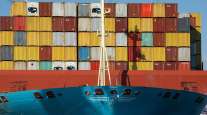US, China Raise Tariffs in New Round of Trade Dispute

BEIJING — The United States and China went ahead with tariff hikes on billions of dollars of each other’s automobiles, factory machinery and other goods Aug. 23 in an escalation of a battle over Beijing’s technology policy that companies worry will chill global economic growth.
The increases came as envoys met in Washington for their first high-level talks in two months. They gave no sign of progress toward a settlement of U.S. complaints that Beijing steals technology and its industry development plans violate Chinese free-trade commitments.
The 25% duties, previously announced, apply to $16 billion of goods from each side including automobiles and metal scrap from the United States and Chinese-made factory machinery and electronic components.
In the first round of tariff hikes, President Donald Trump imposed 25% duties on $34 billion of Chinese imports July 6. Beijing responded with similar penalties on the same amount of American goods.

An online video about U.S.-China trade tensions produced by China's state television plays on a computer screen in Beijing. (Mark Schiefelbein/AP)
The Chinese government criticized the Aug. 23 U.S. increase as a violation of World Trade Organization rules and said it would file a legal challenge.
A foreign ministry spokesman, Lu Kang, declined to give details of the Washington talks.
“We hope the U.S. side will get along with us to strive for a good result from the talks with a reasonable and practical attitude,” Lu said.
Beijing has rejected U.S. demands to scale back plans for state-led technology development that its trading partners say violate its market-opening commitments. American officials worry they might erode the United States’ industrial leadership.
With no settlement in sight, economists warn the conflict could spread and knock up to 0.5 percentage point off global economic growth through 2020.
The pressure on Chinese export industries that support millions of jobs adds to challenges for communist leaders who are trying to shore up slowing economic growth.
Factory output, consumer spending and other indicators were weaker than expected in July. Beijing has responded by pumping money into financial markets and announcing plans for higher spending on public works construction.
Chinese leaders have promised to help struggling exporters and ordered banks to lend more freely to them. But they have avoided full-scale economic stimulus that would set back efforts to rein in surging debt and nurture self-sustaining growth supported by consumer spending.
Forecasters say the impact of U.S. tariffs on China’s economy is small and manageable for now. Credit Suisse said this month that if Trump goes ahead with all threatened U.S. increases, the “worst case” outlook would cut China’s economic growth by 0.2 percentage point this year and 1.3% in 2019.
The International Monetary Fund’s growth forecast for China this year is 6.5%, down from last year’s 6.8% and more than double the U.S. forecast of 2.9%.
Ahead of the Washington talks, Chinese state TV mocked Trump with a sarcastic video posted on YouTube and other social media pages of its international arm, China Global Television Network.
“You are great,” says a presenter on the nearly three-minute English-language clip, reading a letter that pays a satirical tribute to Trump.
“On behalf of doctors, thank you for pointing out the need to wean off American goods like bourbon and bacon,” the presenter says, referring to products on which China imposed retaliatory tariffs.
The video appeared to have been removed Aug. 23 from CGTN’s social media accounts.
Trump has proposed another possible round of tariff hikes involving 25% increases on an additional $200 billion of Chinese goods. Beijing issued a $60 billion list of American products for retaliation if Washington goes ahead with that.
That smaller target list reflects the fact that Beijing is running out of American goods for retaliation due to their lopsided trade balance.
China’s imports from the United States last year totaled about $130 billion. That leaves about $20 billion for penalties after tariffs already imposed or planned on a total of $110 billion.
Chinese authorities have said they will take “comprehensive measures,” which companies worry could mean targeting operations of American businesses in China for disruption.




